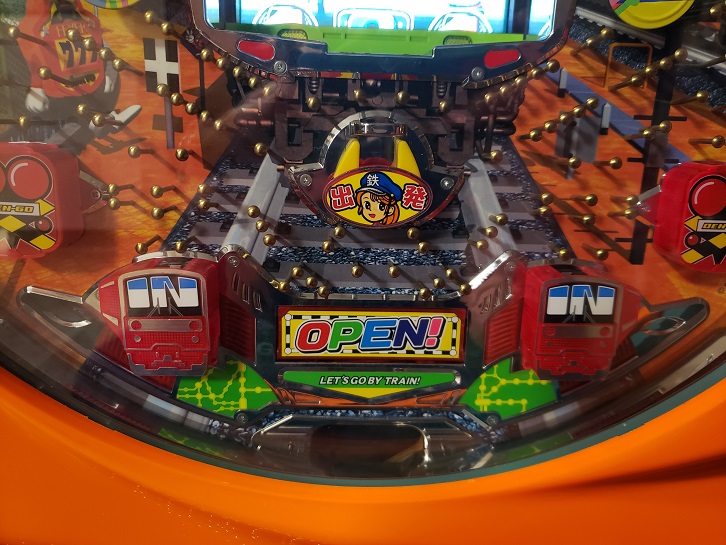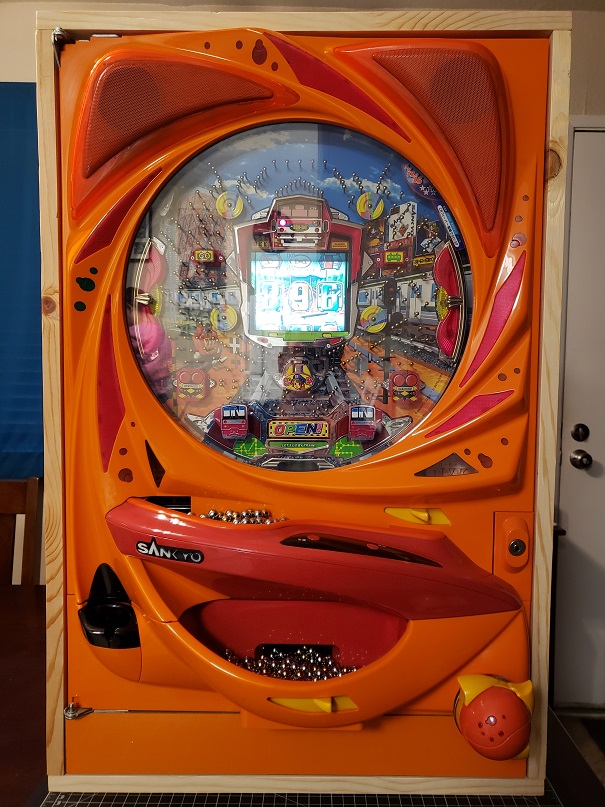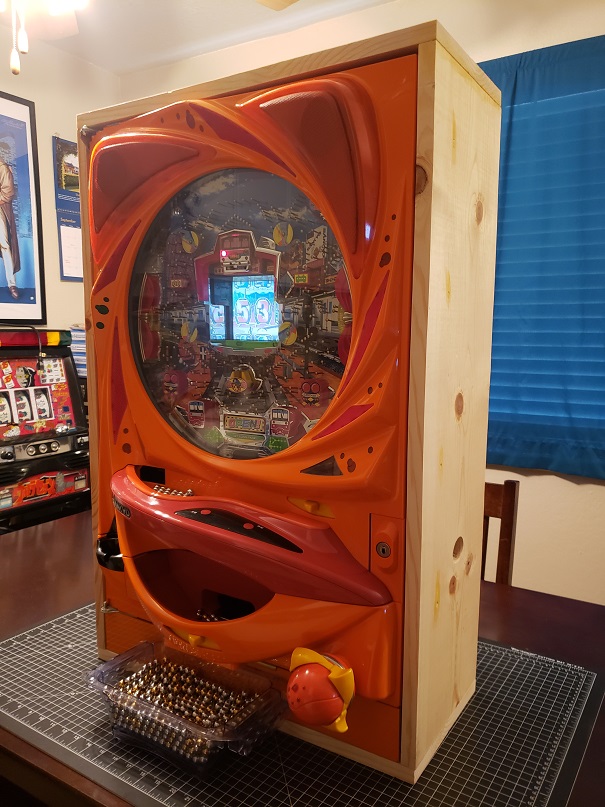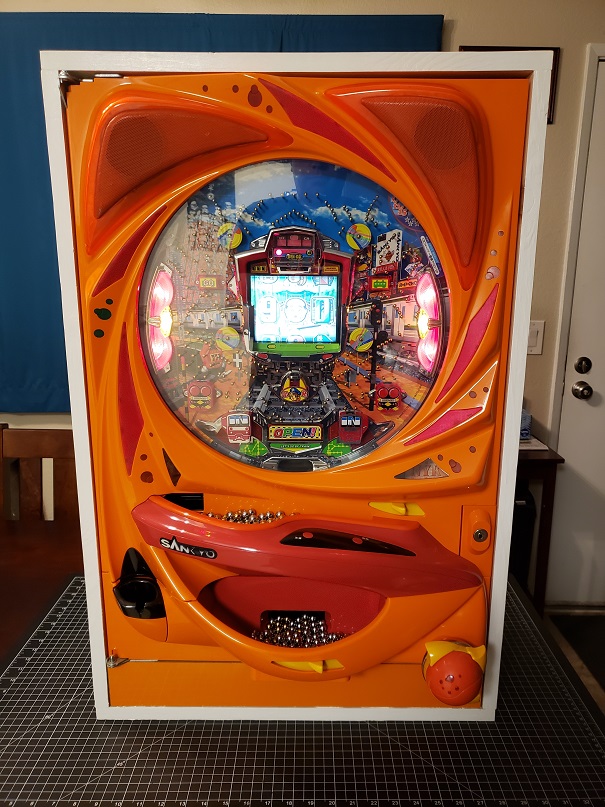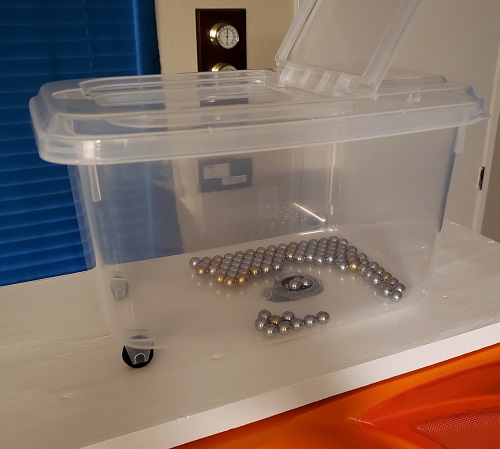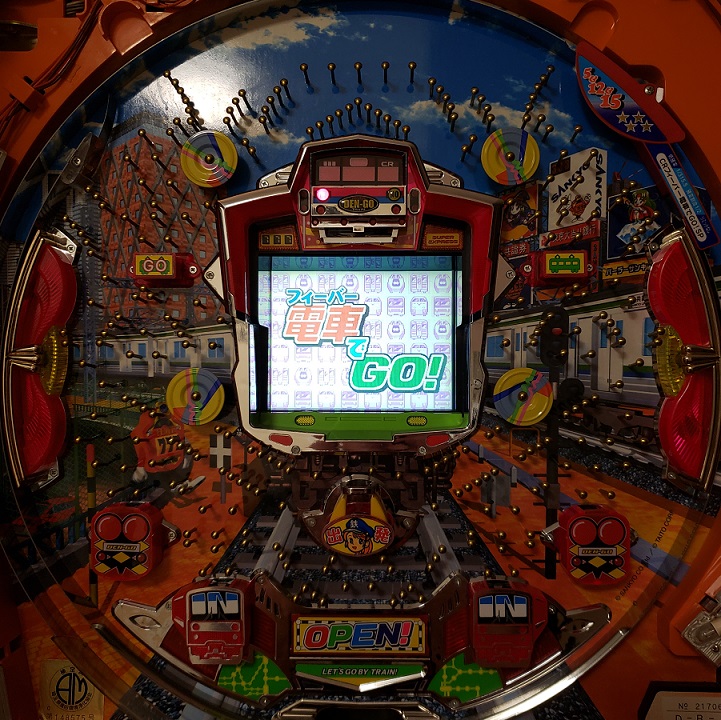
CR Fever
Densha de Go! SP
CRフィーバー電車でGO!
SP (CR Fever Densha de Go! SP)
Sankyo -
Tatsumaki (Tornado) Frame, 2000
I think everyone in a hobby that has
an aspect of limited availability has at least a couple items they
passed up on and have been unable to find ever since. In the
early 2000's pachinko and pachislo were everywhere in the United
States, as there were a number of importers who had massive inventory
and excellent customer service. These companies were Big Bear,
Stealth Home Amusements, Slot USA, and a few others. Even if you
never did business with them, you probably have a couple pachislo
medals embossed with their names. The most over the top and
intricate pachinko machines ever produced came out around this time,
filled with crazy animatronic playfield gimmicks and extremely varied
theming. During both this golden era of pachinko design and
American-based importers, you could purchase pretty much any machine
for between $200 - $300. Pachislo was even less, with Stealth in
particular having crazy sales where you could pick up three machines
for about $100 each, and they'd often toss in a ton of free medals as a
courtesy.
Although I had the means and money to
buy machines then, I erroneously figured they'd always be around and
would always be a couple hundred bucks. Of course that wasn't the
case and many of these machines disappeared almost completely, let
alone stateside. I totally blew my chance for pachislo such as
Carnival Night, Ward of Lights, Super Bunny Girl, Tomcat, King Camel
and other contemporaries. Even worse the chances of finding
pachinko such as Bunny Girl, Indiana Jones, City Hunter, Rocky, and the
subject of this page - Fever Densha de Go! - became slim to none.
Densha de Go! is a series of train
driving video games developed by Taito, which became a bit of a gaming
phenomenon in Japan. The Densha de Go pachinko machines were
released at the peak of the series' popularity and have since become a
prized collectible for fans of the games.
I still kept the search up, now and
then, but even in Japan a couple of these were hard to come by - namely
Bunny Girl and either of the Densha de Go games. In fact the only
PachiTalk forum thread I kept up every now and then was a "want to buy"
thread inquiring about a Bunny Girl pachinko but I only logged in
rarely. Getting into pachislo with my Ultraseven machine lead me
back to PachiTalk and to becoming more active in the community.
To that end I created a couple fresh "want to buy" threads for CR Bunny
Girl and CR Fever Densha de Go. There are a couple different
versions of each machine, which feature different odds and gameplay
tweaks, but I wasn't going to be picky - especially if someone was
local to me.
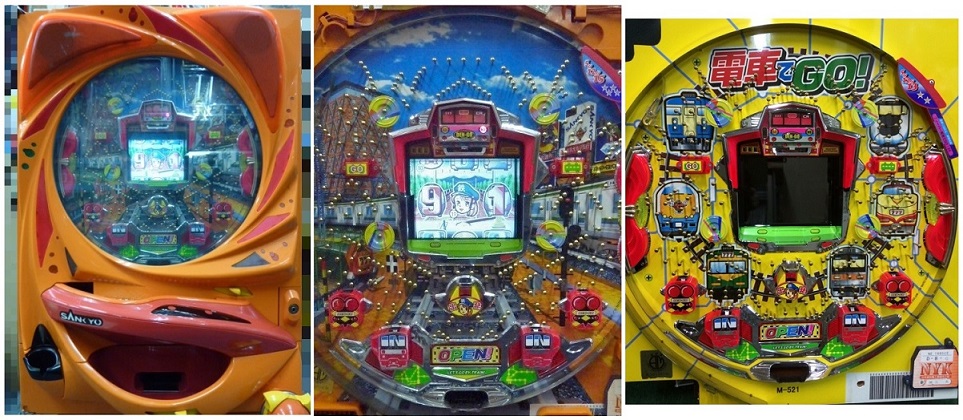
CR Fever Densha de Go! SP in the Tatsumaki frame (left and center), a
CR Fever Densha de Go! EX cell (right).
Following my history of "should have
bought it when I saw it years ago, now it keeps passing me by," a long
time forum member had recently offered a CR Fever Densha de Go! SP
model, in addition to the sequel game. The sequel was picked up
pretty quickly as it has always been in higher demand but he had since
elected to hold onto his machines and the original game was no longer
being offered. I chalked it up as yet another missed opportunity
and this time all because I wasn't as active in the PachiTalk community
as I should have been.
About a month later however, the
stars finally aligned for this machine. The forum member once
again offered a few of his machines for people on PachiTalk who would
take care of them and could pick them up locally. While I wasn't
exactly local, the extremely fair price and couple hours round trip
were easily worth it, especially for a machine I had been trying to
find for years. So one early mid-September morning in 2022 my
wife and I set out down the coast to chase a grail of mine. I met
up with Rich of the PachiTalk forums, took at look at a few of his
machines, talked a bit about pachinko and the community, and picked up
a machine I thought I would never have. Thanks again Rich for
kindly allowing me to bring
this Densha de Go home!
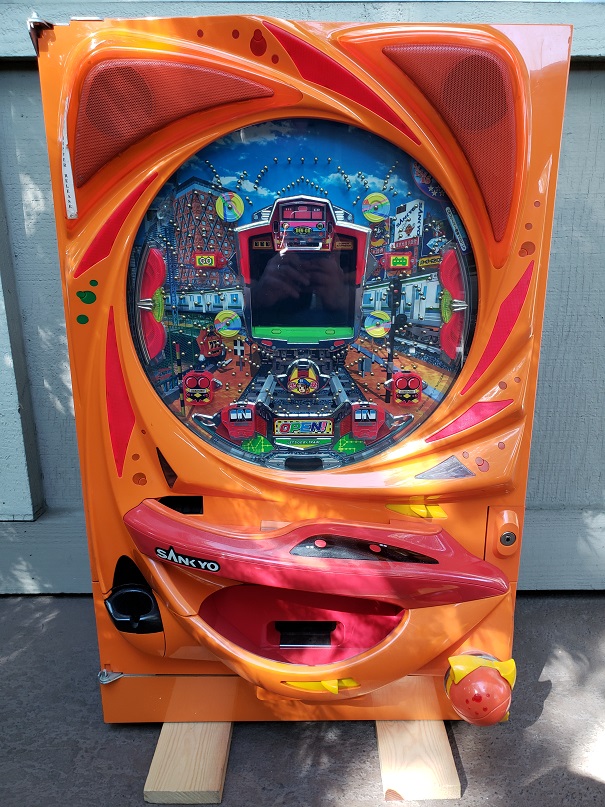
The machine once transported home, in excellent condition with a
beautiful orange Tatsumaki frame.
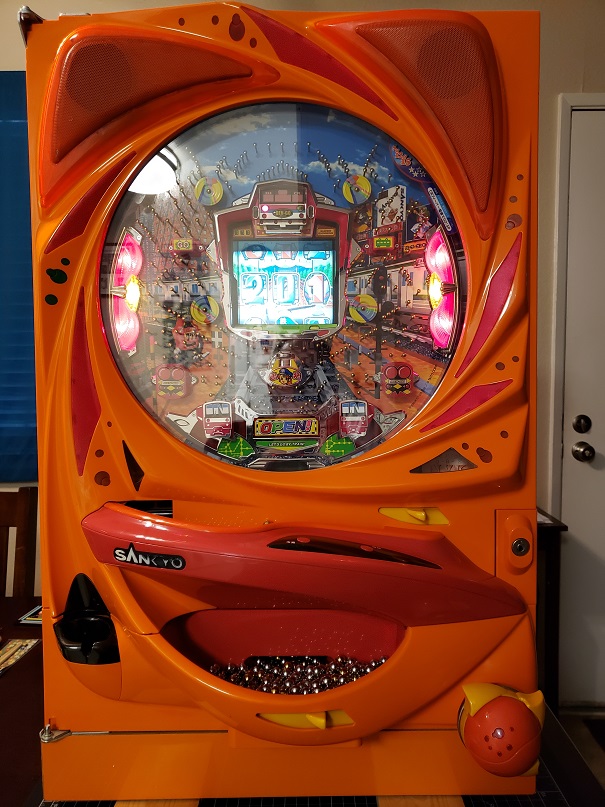
Giving the game its first play after a quick wipe down and cable
reseating after transport.
As it was a game that I knew I was
going to play quite a bit, I wanted to build an enclosure that would
allow me to use it with minimal setup and to protect it while moving it
about my apartment to play. My approach to building enclosures is
to make them as compact as possible, with the ability to add on later -
although I've only ever built a few. This is to allow the
machines to be moved easily as I don't have a specific space to have
everything set up at this point. A permanent extended hopper can
just be added to the top and a drain compartment can just be added on
the bottom if those are desired later on.
I start at the bottom with a runner
that is deep enough to fully contain the entire machine with a bit of
extra clearance, and wide enough to accommodate the vertical boards of
the enclosure so everything rests atop the new base. I have the
boards cut to length at the hardware store and do the fine finishing
work myself. The idea isn't to make it perfect, it's to protect
the machine and give it a larger outer frame. It will also make
the game more stable to stand on its own and allow it to be pushed back
flush against a wall. I also make the enclosure reasonably easy
to remove, as it is secured to the outer pachinko frame with wood
screws and a bit of wood glue but nothing excessive.
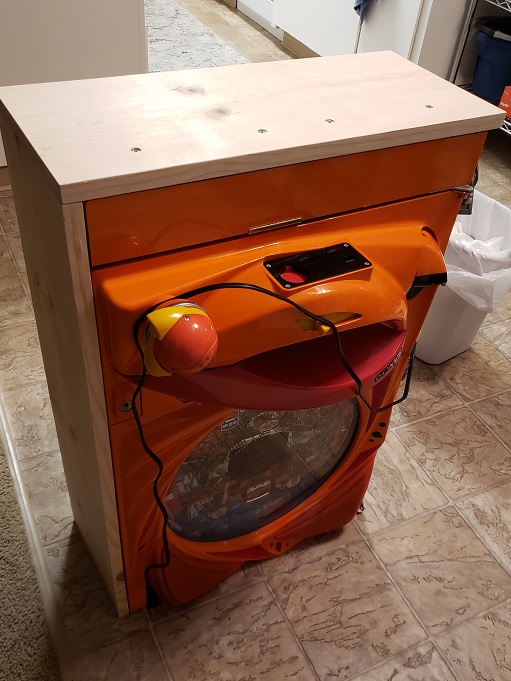
The machine upside down with the bottom runner secured and right side
panel being fitted.
Once the bottom is attached and I'm
satisfied with its positioning, I then attach the sides and level them
off as needed. The top piece comes last and for a modern machine
I drill a large hole in the top panel above the hopper, to allow the
machine to be replenished with balls from the outside. A
temporary or permanent extended hopper can simply be attached up top
with a drain pipe or tube down into the machine.
It's not always perfect and in the
case of this frame I needed to add a couple of shims to make up some
distance on the top. It's important to ensure that both the
playfield access door and the full machine frame swing out can clear
the enclosure without binding or knocking into anything. In the
case of this machine the bit of extra space at the top was necessary to
allow it to open smoothly. This isn't surprising since the
machine wood frames aren't always exactly square after years of being
moved around outside of a parlor installation.
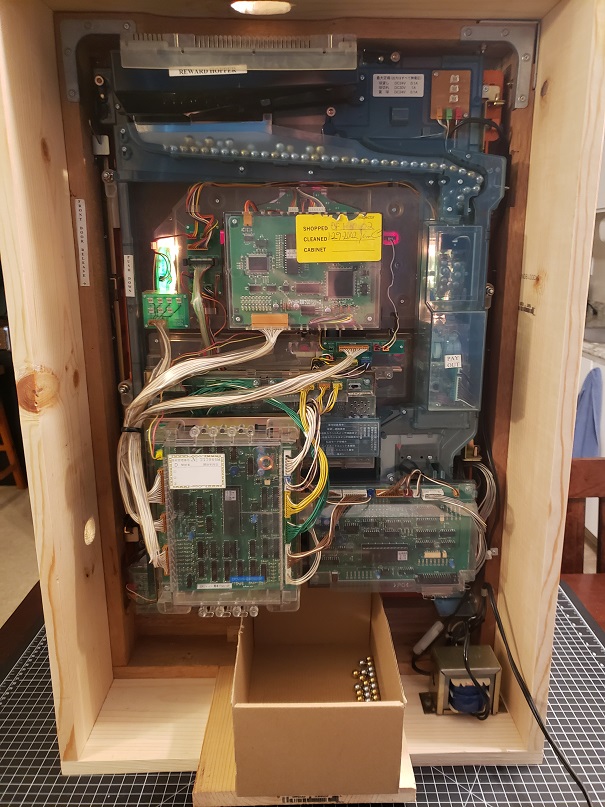
The ball catch tray shown here was only temporary.
The back of the enclosure also needs
to have adequate clearance so that none of the boards or harnesses foul
where an eventual back panel will go. It's also important to
ensure that everything back here can clear the enclosure when the frame
is opened, which can sometimes be an issue with complex machines.
In the case of Densha de Go the wiring harnesses that curve around the
outer edge have to be tucked in just right to ensure they don't catch
on the frame when swung open. I also relocated the transformer to
the base of the enclosure since it will allow for better ventilation
instead of being tucked under the ball races and board stacks.
The back panel is simply a sheet of thin plywood that is secured with
screws so that it can easily be removed if necessary.
When deciding upon a color to paint
the enclosure I settled upon gloss white as I thought the orange frame
would look good surrounded by it.
An individual enclosure means there's
space for a bit of extra fun, so I decided to make cabinet graphics for
the sides. I found the tiny little promotional image that Sankyo
used on their website two decades ago, and was able to remake the
game's logo using another Densha de Go flyer scan and added the "FEVER"
text to mirror it. Amazingly I was able to recover this game's
chibi version of Tetsu-chan (the series mascot) from the promo
image. I was going to do a full redraw and make it smooth but I
like the pixelated result I got initially, as it mirrors her appearance
in the game, and decided to go with that. I also grabbed a Sankyo
logo. I printed them on adhesive vinyl and then used adhesive
laminating sheets to protect the vinyl and ink after it dried.
Nothing fancy here, just home inkjet prints.
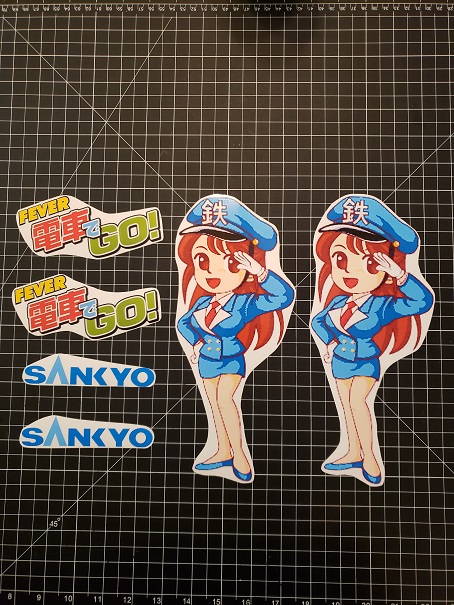
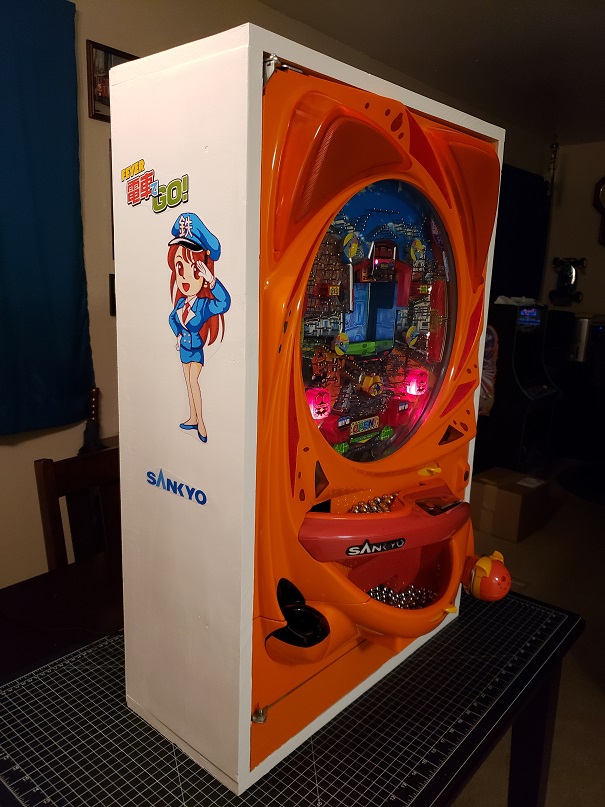
I was surprised with how much I like
the look of the finished side graphics I came up with. I think it
almost looks like something that would be on a trade show demo or the
like. I've since had minor issues with the stickers wanting to
peel away from the gloss painted sides but this was remedied by using a
bit of extra adhesive.
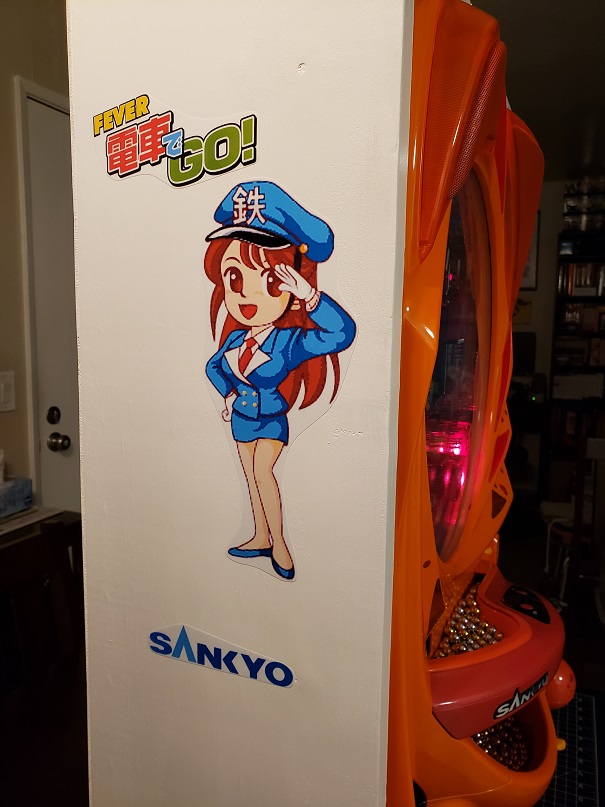
Pachinko machines absolutely need an
aftermarket volume adjustment installed of some kind. While the
machine will generally have a volume adjustment built in, it usually
moves between "loud - louder - loudest" as it is extremely noisy in a
parlor environment. For audio adjustment on this machine I went
with the larger 500 ohm potentiometers as I like the ease of adjustment
they provide. Not wanting additional wires running around the
cabinet, I elected to mount them on the back of the game right on the
top. The leads run through to the speakers on the front via a
wire pathway at the top front door hinge, where there's plenty of
clearance. They're then spliced into the speaker wires at the
front. The heat-shrink is a bit singed as I use cheap heat-shrink
for low voltage.
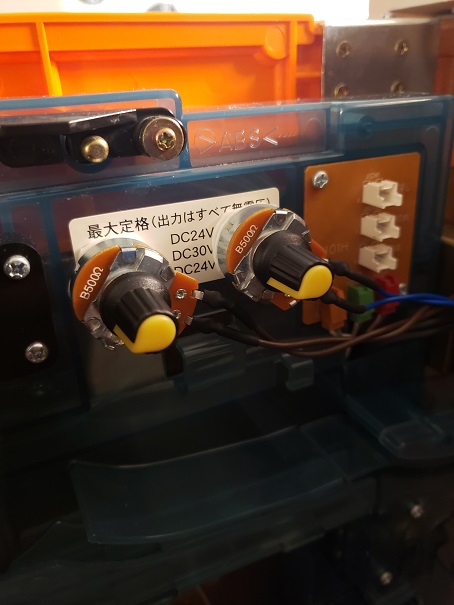
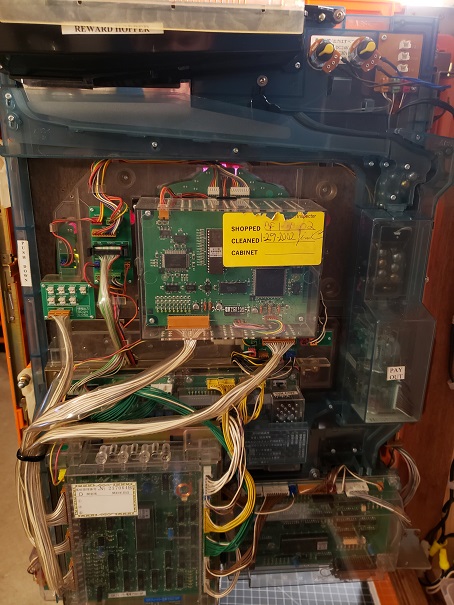
Volume adjustment pots are mounted on the frame itself to allow
adjustment to easily be made when the machine is open.
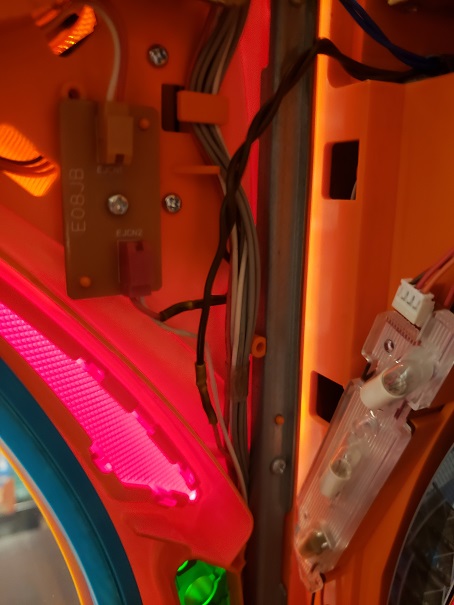
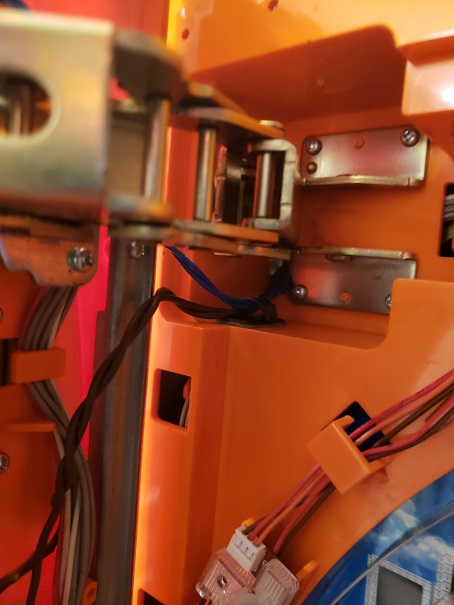
The wires run through an access channel by the hinge and are cleanly
spliced into the speaker lines.
The other side of the cabinet has an
oblong hole to reach in and trip the door release latch. The
large opening at the bottom is to drain out captured balls. The
base board has a bit of a channel I cut into it that directs balls to
roll out the side of the machine and into a catch bin I set beside it
when playing. I know it's not a setup many people use but for my
current situation it works great. If down the road I decide to
build a capture box beneath the cabinet, I can simply drill a hole in
the bottom enclosure board and install a pipe to divert lost balls down
to it.
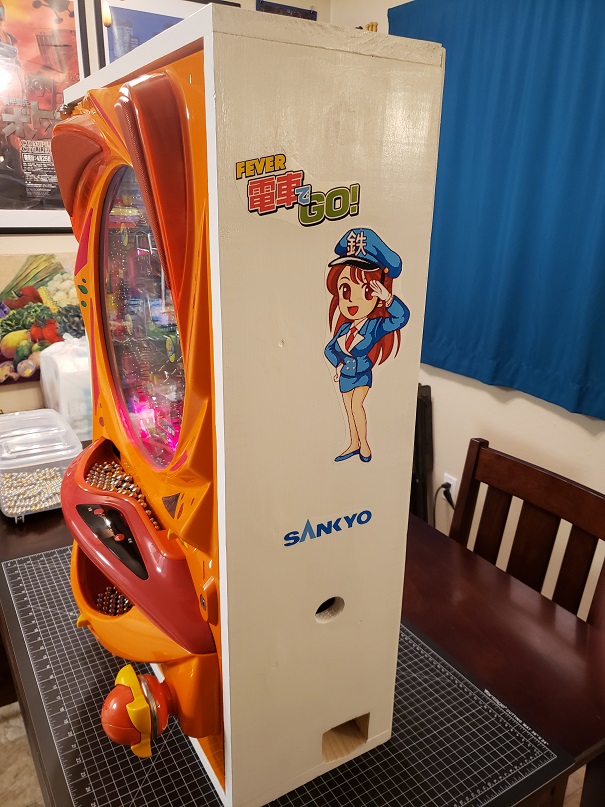
The tray at the bottom is open on the
right side, which allows the balls to fall out into a captive area and
roll down a beveled slope to exit the machine. I eventually
replaced the cardboard guides with some heavy cardstock glazed with
wood glue to make a more solid pathway out of the machine. The
tray can easily be replaced with an unmodified one or removed to allow
a direct drain beneath the cabinet at a later time. I also redid
the transformer connections to ensure they were wrapped and insulated
properly.
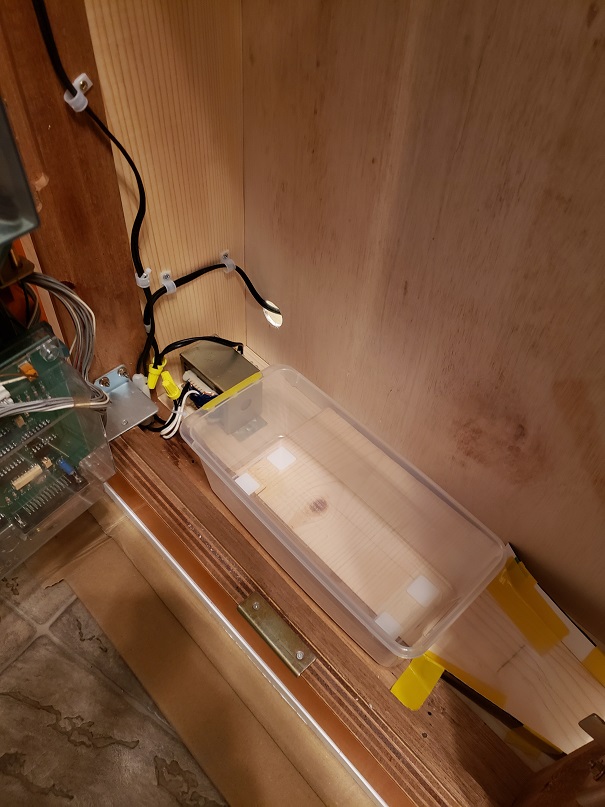
Up top the enclosure has a large hole
to allow the hopper to be refilled or for an extended hopper to be
connected later on. Presently I use a large plastic rice chest as
an extended hopper, with a flexible tube connected to it that sits down
inside the machine to prevent the internal hopper from
overflowing. It looks small in the picture but I estimate it can
hold around 8,000 balls without becoming too heavy. I also use
another of the same container, unmodified, to catch the balls as they
fall away from the drain at the side.
Everything works great with this
setup and I've had no problems with balls refilling or draining out
with no stray balls in the machine. Hopefully one day I'll have a
more dedicated spot for my pachi games and can add permanent extended
hoppers to my machines but this is a great solution for the time being.
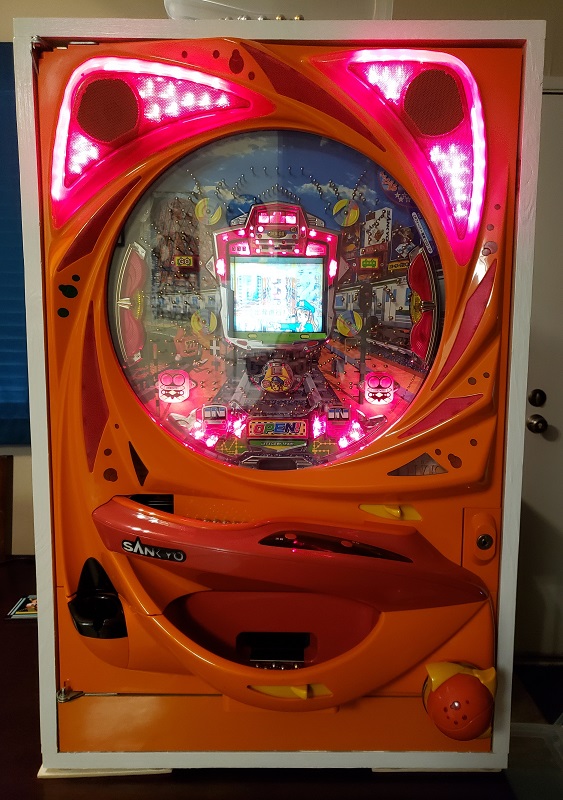
The frame speakers illuminating while in jitan mode.
I really love this game and how much
it is tied into the earlier era of the Densha de Go franchise. I
know everyone is always looking for the sequel machine, which is in the
highly desirable Lumina frame, and while that machine is insanely cool
with all the playfield gimmicks and enhanced modes, it has a very
modern visual motif. This first game really feels ripped out of
the early arcade and PlayStation games, even if it makes the over all
presentation simpler. I'm actually a really big fan of the
Tatsumaki frame, especially the orange version, and it can do some
pretty crazy things during fever reaches and special modes.
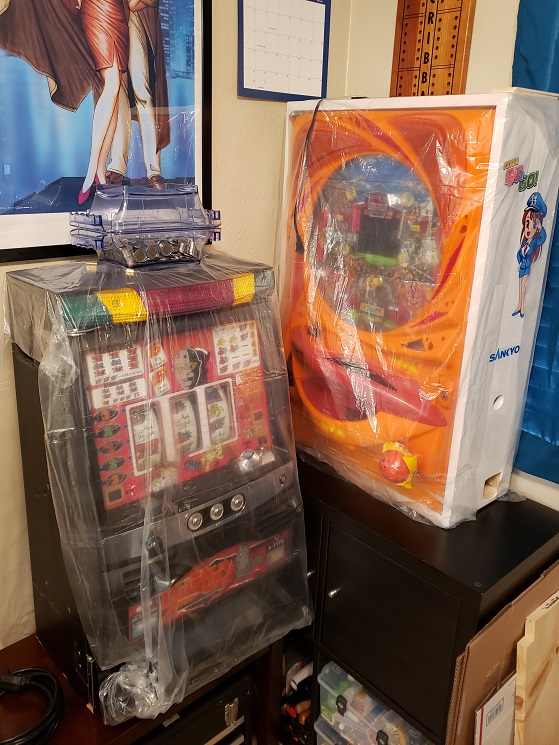
The machine along with Ultraseven pachislo in the corner of the dining
room at my previous apartment.
I feel extremely fortunate to have
this machine in my collection as it really does cross over between a
lot of my different interests. It's also just a ton of fun to
play and is very engaging for a machine of its era. The only
minor issue I've had is there is a line near the bottom of the display
that doesn't illuminate. I opened up the panel somewhat to check
for a bad trace or connection and everything checked out okay, so it
may simply be burned out along that line. It really isn't a big
deal because it's so close to the bottom and I'm just glad it isn't
across the middle or something. The little screens on these
machines weren't designed to be working for so long and it's not
uncommon for them to go out - I'm just glad it works.
Again, a huge thanks to Rich at
PachiTalk for allowing me to acquire this machine and being an
all-around helpful regular in that community.
- - -
Gameplay Sequence and General Payout
Information
I thought I
would explain the gameplay sequence on this machine and provide some
basic information on general things that apply to this era of
pachinko. First off is the "CR" designation that features on most
modern pachinko machines to this day. CR stands for Card Reader
and was a system developed to better audit the cash flow of pachinko
parlors. Rather than using cash to directly purchase balls for
play, cash would instead be used to purchase pre-paid value
cards. A card would then be inserted into a ball loan machine,
usually located between pachinko machines, which would then dispense
balls into the ball tray. Eventually this was changed to simply
using the machines themselves to dispense purchased balls, with the
ball loan machines replaced with a card reader device connected to each
pachinko machine. This facilitated adoption of an industry-wide
standardized interface for card reader enabled machines, hence the CR
designation. For home use this connector is usually simply
overridden via a bypass dongle that allows the machine to operate, but
solutions such as Pinball Dave's Card Reader
Emulator allow for parlor-style functionality in a home environment.
For all
gameplay information specific to this machine, I'll be referencing the
playfield as seen below:
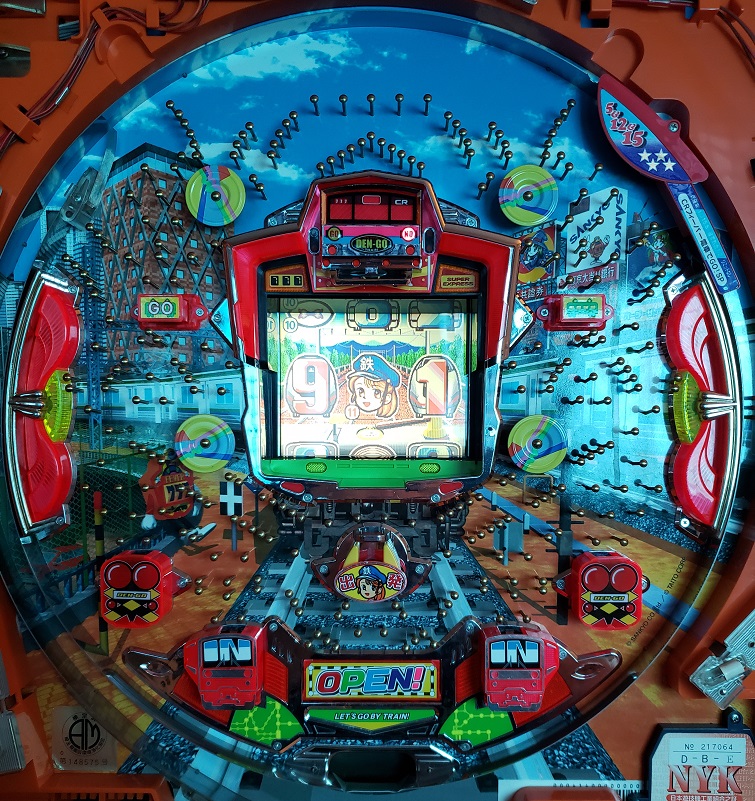
Playfield of a CR Fever Densha de Go! SP.
The playfield
door has been opened in these pictures to allow for clearer
pictures. As you can see in the upper left of this machine, there
is information showing the machine's name, its payout amounts, and
jackpot odds. This is standard for most pachinko machines
manufactured since the early modern era.
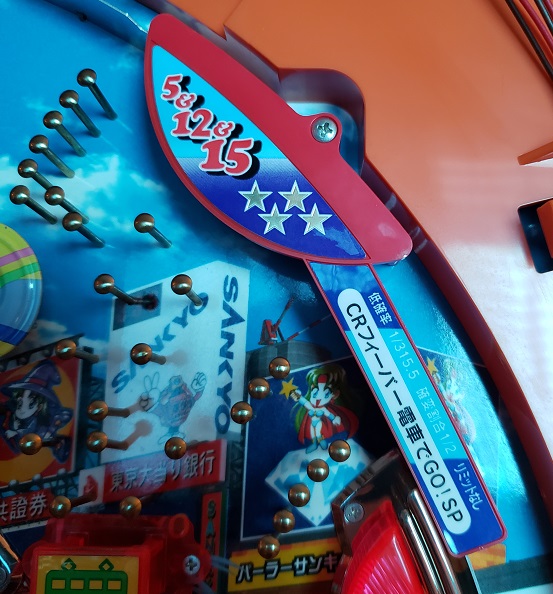
Information in the upper right displays game name, odds, and payouts.
The machine's
name is shown as "CR Fever Densha de Go! SP" with the odds probability
of 1/315.5 reel spins resulting in a jackpot / fever, with a follow up
variable bonus rate of 1/2 for consecutive fever
spins, and no limit to how many may possibly occur. I can speak
from experience that this machine can be very stingy while on the other
side of the coin it can also pay out like crazy. If you are in
the market for a machine that has different versions, pay attention to
what the fever odds are, as that's generally the biggest
difference. Machines that hit something like 1/900 can become
extremely boring in the long run. The numbers "5 & 12 &
15" above denote how many balls the machine will pay out for each ball
that enters a win pocket. In the case of this machine it means
the start chucker will pay out 5 balls, the four win pockets at the
bottom will pay out 12 balls, and the attacker will pay out 15 balls
for each ball that enters. Start chucker? Attacker?
All will be explained below!
The goal of
pachinko is to shoot balls into the machine, have them enter win
pockets, which will then pay out even more balls. This is
accomplished by entering jackpot rounds, called fevers, where the most
valuable win pockets will open up and allow the largest payouts.
On many machines this state is entered by matching combinations on slot
reels, which are spun by getting a ball into a specific win pocket
known as the "start chucker."
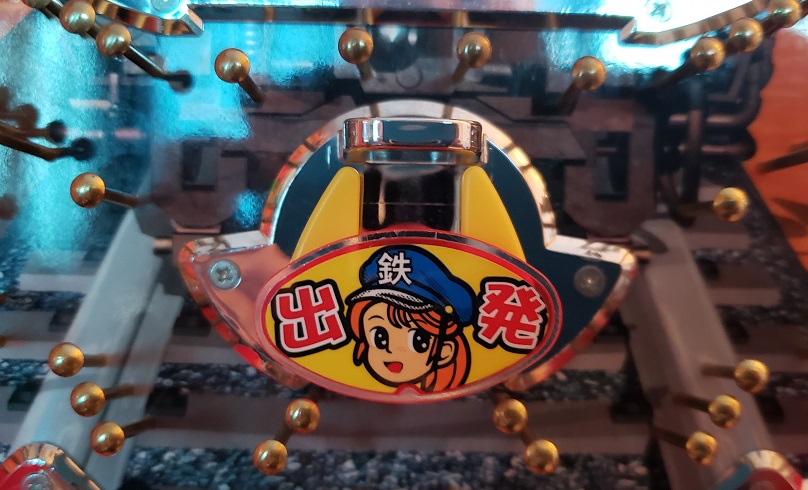
The start chucker on Fever Densha de Go! features game series mascot
Tetsu-chan.
Targeting the
start chucker should be the main objective for every ball fired into
the machine, as the more times the reels are spun, the better the odds
of hitting a fever become. There is usually a preferred path that
cascading balls can be directed along to bring them toward the start
chucker, and finding this sweet spot is one of the keys to
pachinko. In the case of Fever Densha de Go the start chucker is
locked beneath the reel display as a small tulip with the mascot of the
series, Tetsu-chan, on it. Additionally
on this machine the recessed area in front of the reel display will
usually allow balls to bounce in and give them time to settle before
rolling off toward the start chucker.
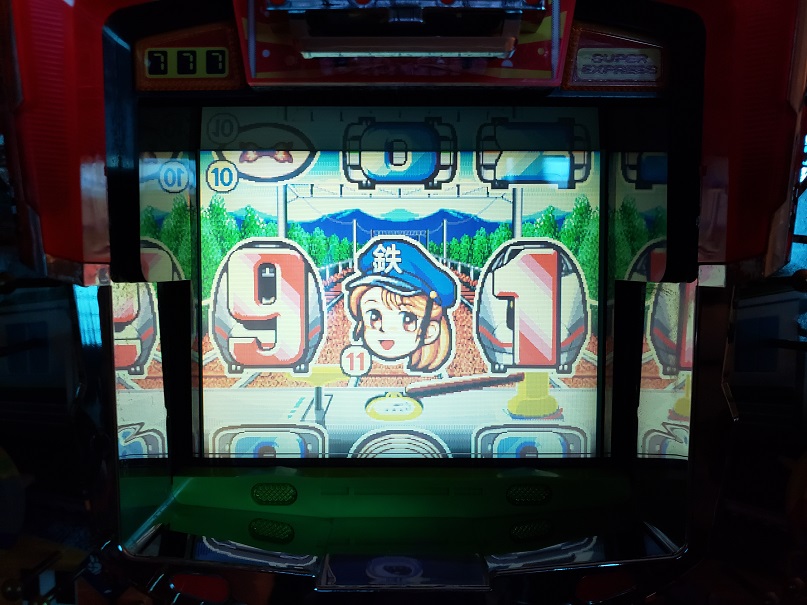
The reels on the display at the center of the machine, these spin when
a ball enters the start chucker.
When a ball
enters the start chucker it will cause the reels on the screen to
spin. For this machine a matching sequence of three of the same
numbers across the center will result in a fever. When two
numbers match, the machine will often enter what is known as a "reach" and a video mode will play as
the final reel continues to spin. These are a big part of the
visual flare of pachinko and are designed to engage the player and pump
up emotion that they may hit a fever. Most of the time a match
isn't made but a lot of the excitement and tension of the game is
created by these sequences, especially when a machine keeps
hitting. Additionally special bonus modes may start up from time
to time that act as mini reaches but will result in a fever if they hit
just the same. Fever Densha de Go has reaches that are themed
after Japanese commuter rail operations featuring comedic characters,
in addition to events those familiar with the games will recognize,
such as stopping a train at the station properly. These modes all
play out automatically with no input from the player, it's all chance
and luck. Additionally every ball that enters the start chucker
will pay out a few balls as the reels spin, as explained earlier that
payout on this machine is 5 balls.
If a reach
results in a combination and a "fever"
mode begins, the door beneath the start chucker will open. This
door is called the "attacker"
and is how the biggest payouts in most games are earned. For many
years conventional pachinko design had the attacker door at the bottom
of the machine but as video displays began to get bigger and take up
most of the playfield, many modern machines moved the attacker over the
right side of the machine.
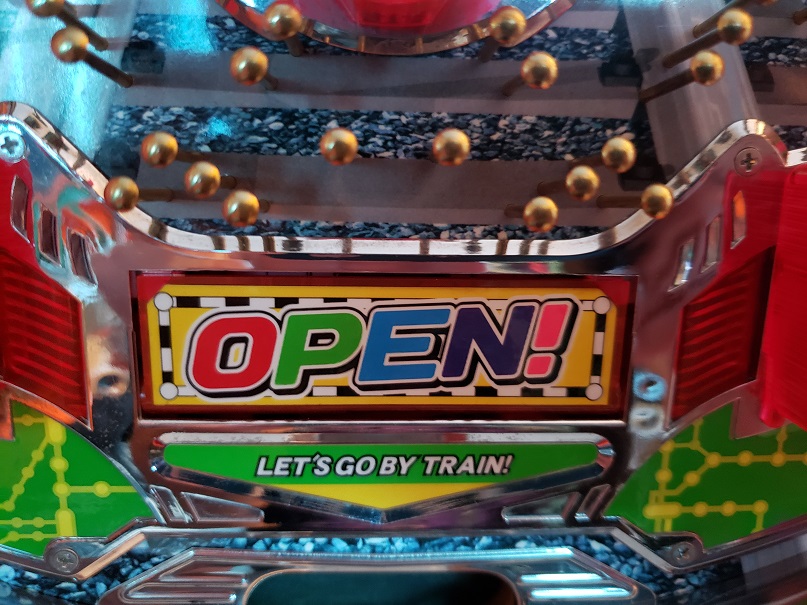
The attacker door will open once a slot combination is hit during a
reach.
Once a fever
mode is entered, every ball should be aimed toward the attacker
door. In the case of Fever Densha de Go, every ball that enters
the attacker will pay out 15 balls. Each fever mode comprises
fifteen rounds, with each round advancing after nine balls enter the
attacker. This means a completed fever mode can pay out a
whopping 2025 balls across the fifteen rounds. This is also why
it is recommended to have 3000 - 4000 balls for each modern machine you
own, with an absolute minimum of 1500.
While each
ball that enters the start chucker will spin the reels, there is a
maximum to how many spins can be banked at a time. Every ball
that enters will still pay out 5 in return, but only four pending spins
can be banked and this status is shown above the reel display on this
machine.
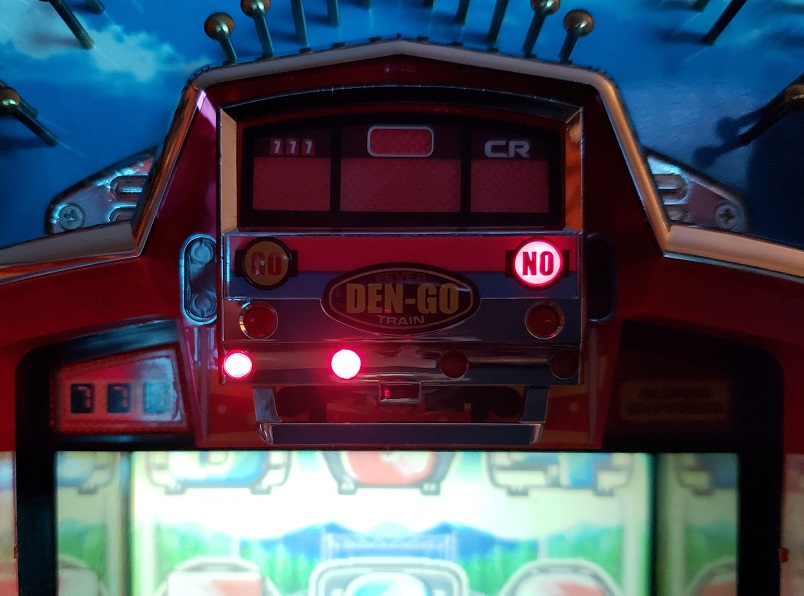
In this case, two reel spins are banked to occur after the current spin
completes.
The four
lights across the bottom of the train above the reel display will
illuminate to correspond to how many spins are banked. Once a
reel spin is banked the reels will spin and complete their sequence
faster than a single spin, preventing too much of a backup and loss of
additional spins.
There is also
a modifier that makes the start chucker easier to hit, although
targeting it is a bit out of the sweet spot path for the start chucker
in my experience. This is called a sub-roulette and is something
common on machines of this era and style. It is activated by
passing a ball through the "GO" target on the upper left of the
playfield.
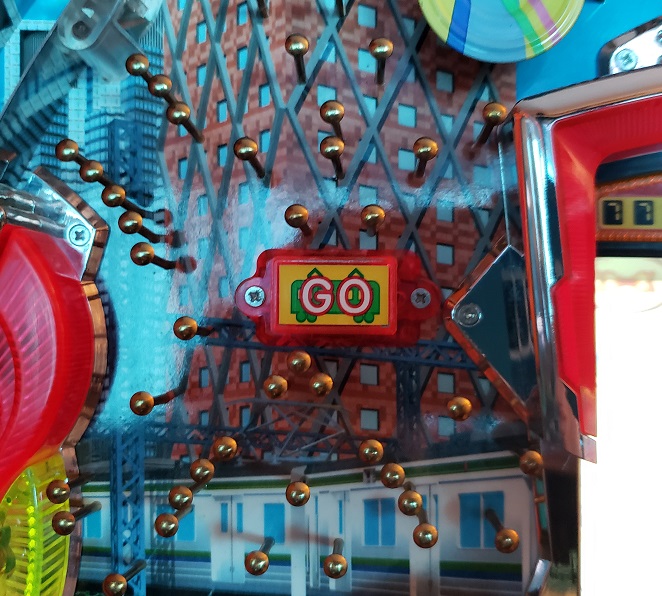
The GO target on the upper left of the playfield, just out of the best
path for the start chucker.
The GO target
doesn't award any balls, instead it starts a countdown. After
about half a minute it will cause the start chucker tulip to open very
briefly, just long enough to have it open and close. This makes
the start chucker a larger target and a couple extra balls can bounce
into it while open, but this moment of improved odds is very
brief. As with reel spins, the sub-roulette can be banked up to
four times. These are shown in the same area where the banked
reel spins are shown.
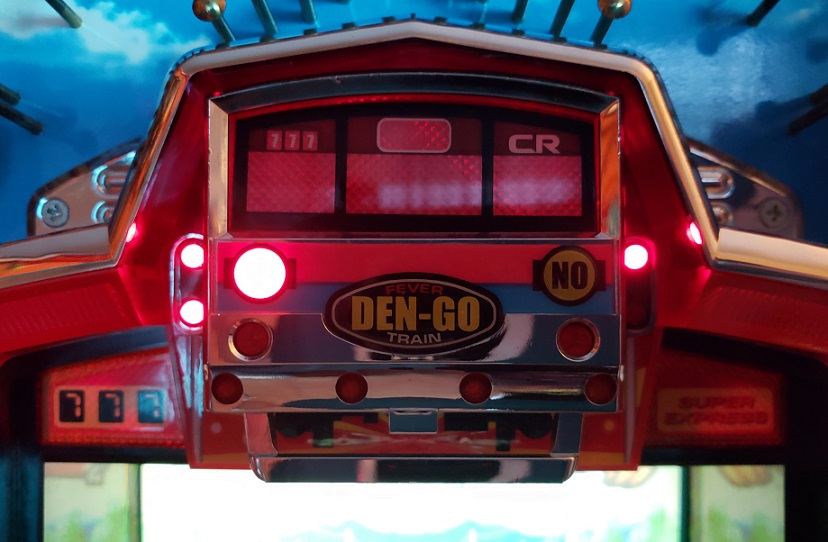
In this example there are three sequential countdowns for the
sub-roulette active, sub-roulettes also cause the train lights to flash.
The signal
lights to the left and right of the train above the reel display denote
how many sub-roulettes have been activated. Each one will start a
silent countdown that will cause the start chucker tulip to open and
close quickly. While the opened tulip isn't something that can
really be targeted since it is open so briefly, keeping the stream of
balls in the general vicinity of the start chucker will still take best
advantage of it. A strategy is to bank sub-roulettes by changing
the ball force just a bit, then returning it to target the sweet spot
once they are lit, moving back and forth during the game flow.
The final
targets on the machine are the "DEN-GO" and "IN" pockets at the bottom
left and bottom right of the playfield. While these will flash
and light up during normal play as various modes are entered, they are
static win pockets that will pay out 12 balls for each ball that enters
one of them.
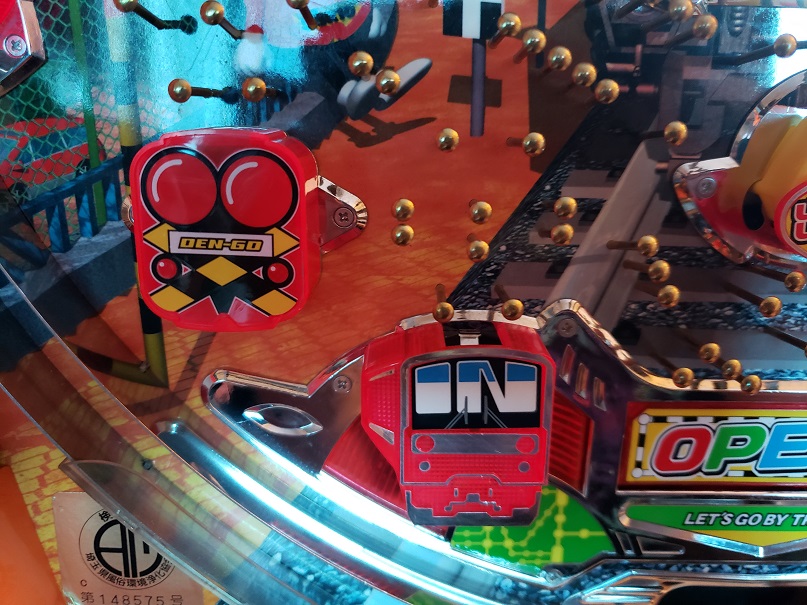
DEN-GO and IN targets on the left side.
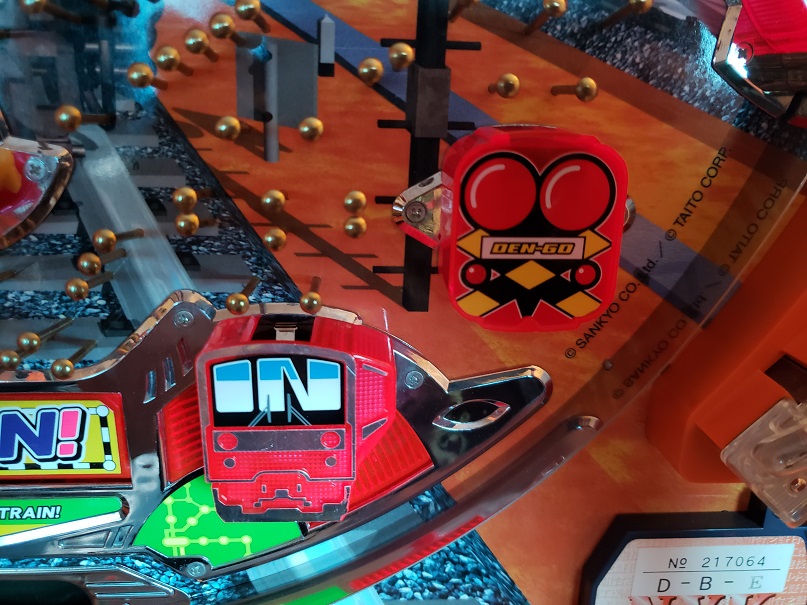
IN and DEN-GO targets on the right side.
As these
targets are so far away from the general path of the sub-roulette and
start chucker, they often only have a ball enter them by chance.
They really aren't worth specifically targeting because the payout in
the long run will always be far smaller than aiming for the start
chucker and entering a fever mode. It's still a nice little bonus
when a ball enters one, especially the left side IN pocket which
sometimes will catch a ball between fever rounds when the attacker is
closed and resetting.
While most of
the detail of this play information is specific to this machine, many
pachinko machines will operate in a similar fashion, especially those
manufactured around the same time. Finding the sweet spot,
adjusting your targeting to activate modifiers, and enjoying the
excitement of reaches and special modes are all things that make
pachinko fun and engaging.
- - -
A
Few Things in Detail
I mentioned above that I replaced the
temporary cardboard ball guides at the bottom of the enclosure with a
more permanent solution. My original intention was to build them
out of some hobby wood but I realized that was overkill for what I
needed. Ultimately I decided to use thick cardstock glued into
place with wood glue. This is an old model railroading and
crafting technique I've used in the past, and with proper reinforcing
struts it is surprisingly strong yet easy to remove if desired later
on. Even in my case this solution is intended to be reasonably
temporary until I have a more dedicated space for my machines and can
add a proper drain compartment to the bottom of the enclosure.
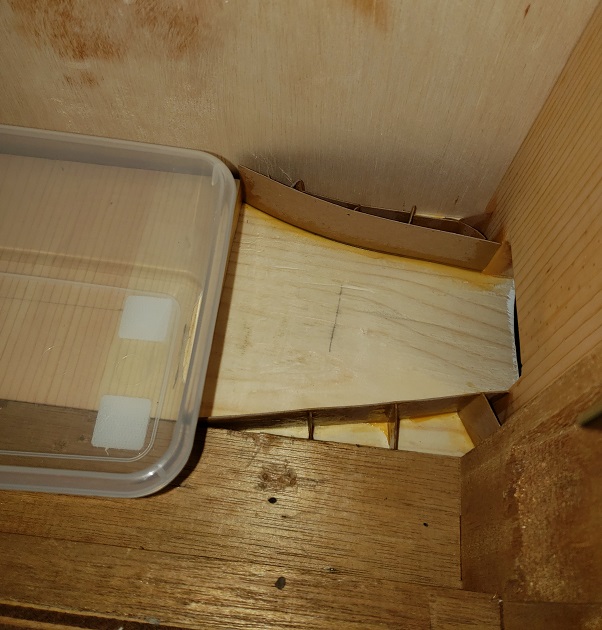
The guides made out of cardstock are as strong as hobby wood but easier
to remove.
Balls that exit the machine fall into
the plastic container, which is angled to have them roll out the side
through a large opening and down a level to where the guides seen above
are. The guides keep the balls funneled toward the beveled slope
that allows them to roll out the side of the machine, where they drop
off into a catch container I place below and beside it when
playing. I have had zero problems with balls rolling stray or not
exiting the machine since going this route. Again, having a
direct drain compartment beneath the machine is a better solution but
until I have my machines in a more fixed location I'm happy with how
this works.
As I also mentioned previously there
is a bad line across the bottom of the display, which has been like
that since I first saw the machine. The screens don't last
forever (these machines were only designed to work for two years or so
originally) and it looks great otherwise so it's not a big deal to
me. Just to be sure it wasn't something simple like a pinched
connection, I did open the panel and all the ribbon cables checked
out. Their connection points also checked out fine and I didn't
want to dig any further, so who knows where the problem is. Even
when the video cable is disconnected and only the backlight is
illuminated, the line across the bottom persists so I don't think it's
a signal problem. I'm just glad it's the only issue with the
machine, is at the very bottom, and is something I can absolutely live
with.
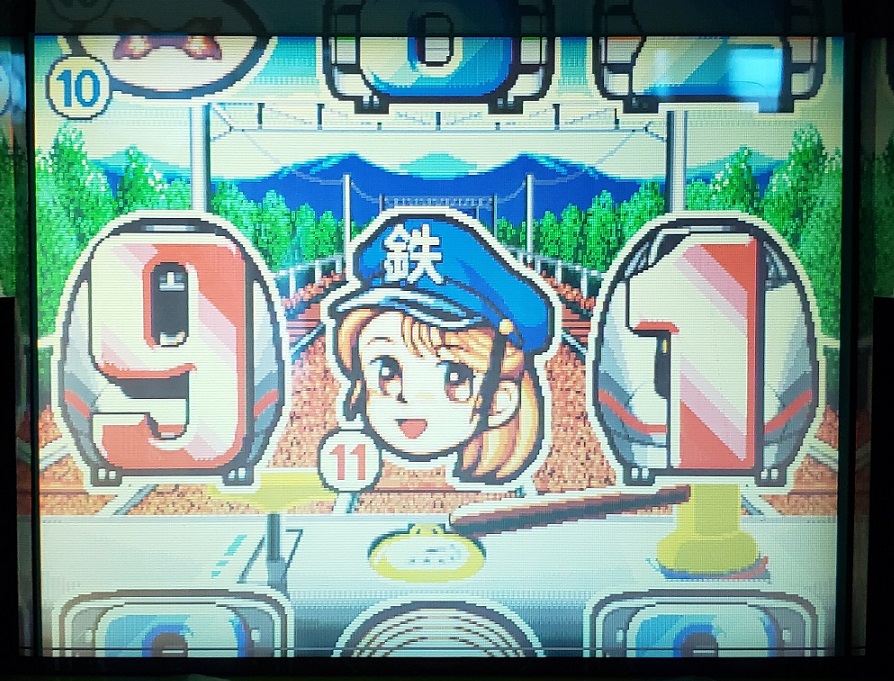
The reel display up close with a single pixel line that is out near the
bottom.
In regular gameplay, depending on how
you sit at the machine, it kind of blends into the bottom edge of the
display feature so it's really not even apparent until I point it out
to someone. Aside from that the display looks beautiful and is
bright and clear without being washed out.
- - -
Last updated
09/28/2023
If you have
questions or comments about pachinko or pachislo, you
can contact me here.
- - -
- - -
Page
Content and Graphics
Copyright 2023 ClassicPlastic.net






